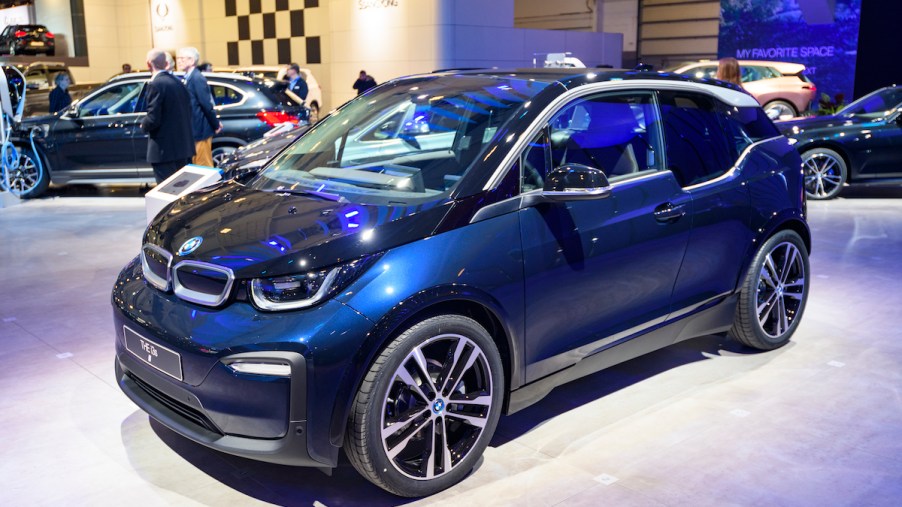
How Far Does the BMW i3s Actually Go on a Single Charge?
InsideEVs recently tested out the 2019 BMW i3s. Its tester took a car borrowed from BMW of North America out for a 70 MPH highway range test. The year-old car had only 600 miles on it. Since there haven’t been any changes to the battery or powertrain between the 2019 and 2020 models, the results should also hold true for the 2020 model. Here’s how the range test turned out for the 2019 BMW i3s.
The 2020 BMW i3 and i3s
The BMW i3 and BMW i3s are similar, but the i3s offers additional power and its chassis has sportier tuning. The BMW i3 and i3s’s unique design makes them good for city driving. They have a small overall size with a short hood and larger front seat space. Their rear seats and cargo area are quite small as well. They are also tall and wide to give a good view of the road. Their thin tires make the cars more aerodynamic.
The cars are made from carbon-fiber-reinforced plastic, which is light, strong, and expensive. The interior features primarily recycled or renewable materials. Tech is provided across two screens, and the system is compatible with Apple CarPlay but not Android Auto. It doesn’t offer anything like Tesla’s Autopilot or a 360-degree camera.
The BMW i3 has 170 hp and 184 lb-ft of torque, and the i3s has 184 hp and 199 lb-ft of torque. While not the speediest electric vehicles, the i3 goes from zero to 60 MPH in 7.2 seconds and the i3s does it in 6.8 seconds. Their top speeds are 93 MPH and 99 MPH.
The EPA’s range estimates
The EPA rated the 2019 and 2020 i3 and i3s for 153 miles. This is an increase from the 2018 i3 and i3s. That model year was rated for 114 miles on the i3 and 107 miles on the i3s. The car received a new larger battery pack for the 2019 model year, delivering 442 kWh and increasing the EPA-rated range.
InsideEVs expressed surprise that the i3 and i3s received the same EPA-rated range, since the i3s has wider tires and more power. It expected the i3s’s range to be lower than that of the i3 rather than the same. There are also range-extended versions of the i3 that include a gas engine along with the electric motor, bumping the total range up to 200 miles.
InsideEVs’ highway range test
InsideEVs tries to standardize the test variables as much as it can, including setting the tire pressure to the manufacturer’s recommended pressure. The tires on the 2019 i3s are wider in the rear than the front, so BMW recommends setting the front tires to 39 psi and the rear tires to 44 psi.
The car had a warm day for its test, starting at 87 degrees Fahrenheit and ending at 95 degrees Fahrenheit. The air conditioning was set to 70 degrees with a fan speed of one, the lowest setting. The wind was blowing at just four or five MPH. Testers drove the car in the default drive mode of Comfort.
During the test, InsideEVs drove the 2019 i3s for 139.5 miles and completed the test with 1% charge remaining. It estimates that 141 miles would have used the full charge. That works out to 3.6 mi/kWh, which makes sense since the usable battery capacity is about 39.2 kWh.
Shortcomings of the BMW i3s
InsideEVs’ range test came up with a lower result than the EPA’s rating, with 141 miles compared to 153 miles. The InsideEVs tester did note that the mi/kWh consumption rate for the i3s, as with other EVs, was lower during the first part of the test than during the second half. The consumption rate was one or two tenths higher later.
Many other EVs tested also came up short of the EPA’s ratings, but the 2019 BMW i3s still has a lower range than a number of other options. Six test cars have EPA ratings between 170 and 310 miles and InsideEVs ranges between 171 and 290 miles. These top performers are the 2020 Hyundai Ioniq (EPA 170/InsideEVs 171), 2020 Nissan LEAF SL Plus (EPA 215/InsideEVs 190), 2020 Chevrolet Bolt EV (EPA 259/ InsideEVs 226), 2020 Hyundai Kona Electric (EPA 258/InsideEVs 238), 2020 Tesla Model Y (EPA 316/ InsideEVs 276), and 2019 Tesla Model 3 LR AWD (EPA 310/ InsideEVs 290).
InsideEVs mentions that it can’t control for all possible variables during its tests, so the results aren’t going to be perfect. While the 2019 BMW i3s will meet most drivers’ range needs, there are other electric vehicles which outperform it and provide much more available range.


